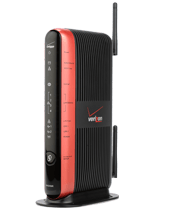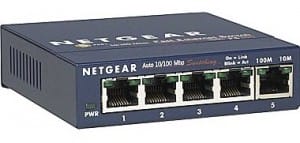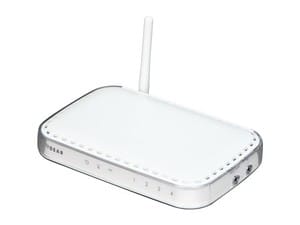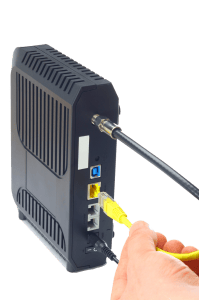New FIOS Router?
 New FIOS Router?
New FIOS Router?
I just upgraded my home FiOS system. Now that I have the new Verizon router in hand, I am concerned how it will work with the Netgear wireless routers we attached to the old router. While the installation instructions look ‘stupid simple’ I wonder if I will run into challenges when I upgrade the Verizon device. I also wonder if I need to upgrade our Netgear Wireless routers -they are quite dated. I read that the best routers are Netgear’s Nighthawk X6 AC3200 and D-Lins AC3200 Ultra Wi-Fi, can you confirm this for me as well?
Perhaps first I should give you a quick run-down on what equipment you are (or should be) using on a home network:
Internet Access: This will be your new FIOS gateway device, and connects using a coax cable from your Verizon Network Interface Device (that’s the big white box attached to your wall). Verizon’s gateway device combines a modem (the part that converts signals from one type to another needed to get internet service out of a coax cable) with a router (the part that distributes the internet service out the Ethernet ports on the back and out the antennas to your wi-fi computers).
You might be thinking of these as separate devices and yes, in the past you often saw separate cablemodem boxes attached to routers. But that’s no longer needed for most home installations, the gateway device handles both functions. I should add that you only want to have a one single router on your home network. A router’s function is to assign internet protocol (IP) address numbers to all the computers, printers and other devices that are on your home network, including wireless devices like your smartphone or tablet. It just confuses things to have multiple routers as they all try to assign numbers – you really can have only one ‘boss’ of your network. A router usually has four or more ethernet ports to which you can connect any other network gear, printers or computers.
Switches or Hubs: If you need to distribute your network via ethernet cabling You might have one or more of these in place. They take one cable coming from your router, and provide multiple ports for additional cables, passing signals from one device to another. Homes that have Ethernet cables run throughout the house may have a large version of this with 20 or more ports. You can have as many of these devices as you need to get your network everywhere in the home.
 Wi-fi Access Points: If you have a large home, the wi-fi signal from your FIOS router may not reach every corner. In this case you’d install one or more Access points to extend the wireless network range These may look just like a router, but they don’t handle the all-important IP address assignment function of a router, they just pass signals along, the same as switches or hubs – this is not a router!. They have one Ethernet port on the back where you plug in a cable connected to your home network. You might see a variant of this, the Wireless Extender which only needs electric power. This takes an existing wireless signal (so it must be in range of your FIOS router), and boosts it to cover an area around it. You can have as many Access Points or Wireless Extenders as you need to ensure full wi-fi coverage of your property.
Wi-fi Access Points: If you have a large home, the wi-fi signal from your FIOS router may not reach every corner. In this case you’d install one or more Access points to extend the wireless network range These may look just like a router, but they don’t handle the all-important IP address assignment function of a router, they just pass signals along, the same as switches or hubs – this is not a router!. They have one Ethernet port on the back where you plug in a cable connected to your home network. You might see a variant of this, the Wireless Extender which only needs electric power. This takes an existing wireless signal (so it must be in range of your FIOS router), and boosts it to cover an area around it. You can have as many Access Points or Wireless Extenders as you need to ensure full wi-fi coverage of your property.
Think of wi-fi coverage as a very large (say 100 meters or more) doughnut with the router, access point or wireless extender in the center hole. You have a wi-fi signal anywhere inside the doughnut. So you might place an access point on each floor of your home to get good coverage, or place a wireless extender near the outer edge of your FIOS router to send signal further away from the FIOS router.
 And finally, you will have Ethernet cables: one each running from your FIOS router to other devices or into the wall and to a wall port if your home is ‘wired’). This wiring provides the path for your devices to communicate. You’ll also have the invisible path provided by your wi-fi equipment (access points, range extenders and the computers, smartphones and tablets that connect to wi-fi).
And finally, you will have Ethernet cables: one each running from your FIOS router to other devices or into the wall and to a wall port if your home is ‘wired’). This wiring provides the path for your devices to communicate. You’ll also have the invisible path provided by your wi-fi equipment (access points, range extenders and the computers, smartphones and tablets that connect to wi-fi).
Whew! To recap, you only want one cable modem and one router, but you can have many other networking switches, hubs, access points or range extenders to make sure your internet access is good throughout your home. It is possible that your home was configured with a router attached to your old FIOS router. If this is the case, replacing your FIOS router and using the exact same Ethernet cable connections should result in no problems with your home network. Your Netgear router performs the same IP address assignment function as it did before, and the FIOS router isn’t doing anything for you.
But I’m guessing that your old FIOS router also had wi-fi built in, so this can cause a problem: Each router creates its own network and manages all the devices connected to it. So for example, if your laptop was connected to the FIOS router’s wi-fi, and you tried to print to a printer connected to your Netgear router’s system, your laptop might not be able to ‘see’ the printer and print. That’s why it’s always best to stick to one router assigning numbers.
By the way, you can solve the problem I noted above by going into your FIOS Router’s control panel (point your browser to 192.168.1.1 and log in with the username and password that’s printed on a sticker on the FIOS router). From there you should turn off the wireless function and let all your devices depend on the other wi-fi gear inside your Netgear router’s network.
Other potential problems you might encounter when you replace networking gear:
If you’ve been using a Netgear router and switch to using the FIOS router, there will be some IP addressing changes to deal with. Netgear uses 192.168.0.xxx numbering and FIOS uses the 192.168.1.xxx variant – the little change from a 0 to a 1 can make all the difference. All the devices on your network need to have the same variant, called a ‘sub-net’ in order to communicate. The last three characters (replace the xxx with anything from 1 to 256) is the unique assignment for each device on the network – there can be no duplicates!
So you might run into trouble depending on how you installed the printers onto your network (these are printers that attach with Ethernet cables, not printers that attach to computers with USB cables). Network printers and all network devices have a unique IP address either manually assigned or dynamically assigned from the router. When you install the printer software onto your computer, you might use that IP address, and if the IP address changes or doesn’t match the sub-net of your computer, you won’t be able to print. That’s only one way that printers get installed on computers, so having different IP addresses might not stop you from printing – you’ll have to try it and see.
As you can see, this is why computer technicians are often called in to help setup, repair and maintain networks – even home networks. It can be very complicated! So let me leave you with one last piece of advice: Try to make things as simple and straightforward as possible. Here’s some tips:
- Use your FIOS router and remove any other routers on your network. Use only switches or hubs, Access Points or Range Extenders to get a wired or wi-fi signal throughout your home.
- Reset any network printers to use an IP that fits within the FIOS numbering structure (192.168.1.xxx). You should probably use high numbers so they won’t conflict with any addresses that the router assigns dynamically. So you could assign the IP address 192.168.1.200, 192.168.1.201 and 192.168.1.202 to three different printers.
- Now visit every computer where those printers are already configured, and change the printer setup to use the IP you just assigned. Better yet, if there’s an alternate method other than assigning the IP address, use it.
Once you’ve done that, everything should work just fine, and you’ll have a much simpler setup in case you run into any problems in the future. You might want to take the extra step to make a list of all your networking equipment including brand, model number, MAC address, and any login information. If you’re handy with graphics, create a visual document showing all your equipment by location.
This website runs on a patronage model. If you find my answers of value, please consider supporting me by sending any dollar amount via:
or by mailing a check/cash to PosiTek.net LLC 1934 Old Gallows Road, Suite 350, Tysons Corner VA 22182. I am not a non-profit, but your support helps me to continue delivering advice and consumer technology support to the public. Thanks!







Hi,
I have the router listed in your picture with FiOS. It is connected internet wise by ethernet to the wan connection. Also, there is the coaxial cable which transfers info like tv guide for FiOS tv.
I am buying a Linksys dual-band router. If I delease the wifi in the router settings and move the ethernet from the FiOS router to the Linksys wan, then use a separate ethernet to connect the 2 routers lan to lan I am hoping I’ll get the internet on the new router and still have the tv guide and other functions because the 2 routers are connected. Or am I thinking incorrectly here? Thanks Al
Hi Al, If you read my article, you know that you don’t want two routers controlling your home network. You’ll want to disable the “routing function” in one of them – usually that’s a secondary router (not the FIOS router).
Are you (1) trying to extend the reach of your Wifi network (adding the Linksys router and locating it away from your FIOS router)? Or are you (2) simply trying to get faster Wifi speed with a new router?
I wouldn’t mess with the connections your FIOS router has with the NID (coax and ethernet) as your FIOS service may depend on that router fulfilling all the FIOS service functions. FIOS TV One service uses both coax and ethernet to achieve gigabit speeds while still delivering FIOS services like VOD and the Guide. Services like Quantum may only need the coax cable since they are usually 100Mbps or less in speed.
Instead of LAN to LAN connection between the FIOS router and the new Linksys, I’d suggest you connect an ethernet cable from the FIOS router’s LAN port to the Linksys router’s WAN port, and then disable the Linksys routing function (set it in bridge mode). Now you can setup the Linksys Wifi either as a new Wifi network (if #2 above), or extend the existing FIOS Wifi network (if #1 above).